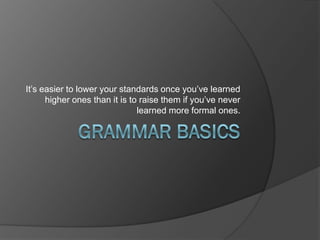
Grammar basics a c
- 1. It’s easier to lower your standards once you’ve learned higher ones than it is to raise them if you’ve never learned more formal ones.
- 2. Examples: A person should mind their own business. (his or her) Several employees had to go outside and lay down after the fire. (lie) Hopefully, the snow will miss our area. (Hopefully doesn’t say who is hoping)
- 3. 8 parts of speech Nouns, pronouns, verbs, adjectives, adverbs, prepositions, conjunctions and interjections Parts of speech refer to what words ARE
- 4. Parts of a sentence Subject, predicate, predicate complement (predicate nominative and predicate adjective), direct object, indirect object, noun of direct address, appositive, sentence adverb, prepositional phrase, subject of an infinitive, and so on. Parts of a sentence refers to what words DO or how they are used in a sentence.
- 5. And then there are… Verbals: infinitives, gerunds, participles Groups of words: phrases, clauses, sentences Rather than define all of them right now, let’s look at them as they come about so you take in only as much terminology as is necessary.
- 6. Common mistakes a/an: a is used before a word that begins with a consonant sound when pronounced an is used before a word that begins with a vowel sound when pronounced ○ Abbreviations: the choice is determined by the initial sound ○ …an FBI inquiry (initial sound is ef) ○ …a historical event (initial sound is hih)
- 7. Other “a” mistakes “A lot” is always two words Adjective-adverb confusion: adjectives modify nouns or pronouns Adverbs modify verbs, adjectives or other adverbs Everything was running smoothly – modifier describes the manner in which something was running – it modifies the verb Or say, everything was smooth, because smooth would be the adjective modifying everything
- 8. Adopt/pass You adopt a resolution. You pass an ordinance Affect/effect Affect is a verb meaning “to influence” Effect is a noun meaning “result” and a verb meaning “to cause”
- 9. Other “a” mistakes As/like As is a conjunction and should be used to introduce a clause Like is a preposition and should be used to introduce a word or phrase Among/between Use between for two items; among for three or more Alleged and allegedly Avoid these as modifiers, for they don’t offer the legal protection many would think. Don’t write, “He is an alleged rapist.” Just say, “He is charged with rape.”
- 10. B Blond/blonde Brunet/brunette The forms without the final e are used when applying to a man only. The forms with the e are used only as nouns applying to a woman.
- 11. C Centers around – change to centers on or revolves around because the center is in the middle Colon – capitalize the first word after a colon if what follows is a complete sentence He said you could summarize the message in three words: Love thy neighbor.
- 12. Comma Put a comma before a conjunction such as “and” and only if what follows could stand alone as a complete sentence Or, if the “and” could be confusing reading as linking the last two items as one rather than leaving them separate: Corn, pork, and beans
- 13. Comma-splice sentences A comma alone is not enough to connect two independent clauses. Add a conjunction such as “and” after the comma, change the common to a semicolon, or change the comma to a period and capitalize the next word.
- 14. Compare to/compare with Use compare to when similarities are stressed Use compare with when differences are stressed Compose/comprise/constitute The whole is composed of the parts or comprises the parts. The parts constitute the whole
- 15. Conditional mood Use could, not can Might not may Should not shall Would not will Don’t write, “The bill will make gun owners…” Write, “The bill would make gun owners…”
- 16. Contact Avoid as a verb. Use call, write, visit Convince/persuade You’re convinced that or convinced of something. You’re persuaded to do something.
